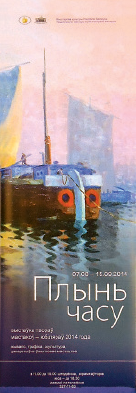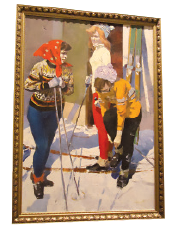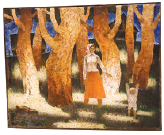One of the most surprising impressions of this exhibition is to find that works created many years ago still look modern and that they cause vibrant feelings. This obviously can be explained by the sincerity and talent of the artists and universality of human emotions.

National Art Museum displays pictorial art by artists, celebrating a jubilee in 2014, who are connected with Belarus in some way
The National Art Museum exhibits paintings and sculptures of artists celebrating a jubilee of 2014 and who are somehow connected with Belarus. Such exhibitions have already become a tradition. The present one represents the work of more than fifty artists, whose anniversary falls on this year. Anniversaries are different: from 160 to 60 years.
 The exposition includes works of well-known masters and less eminent creators: Yehuda Pen and Vladimir Kudrevich, Leiba Alperovich and Zenon Lensky, Pavel Yuzhik and Sofia Li, Valentin Dzezhits and Lev Dominsky, Isaak Milchin and Konstantin Zavishi, Nikolay Kazakevich and Leonid Osedovsky, Andrey Zaspitsky and Yury Polyakov, Natalia Chernogolovaya and Svetlana Gorbunova, Mikhail Pluzhnik and Vladimir Mudrogin, Vasily Yermolenko and Vyacheslav Rozhkov, Vladimir Novak and Alexey Petrukhna, Vera Kozak and Vladimir Papsuev, Victor Gross and Valentina Golubkina, Nikita Sandzhiev and Yana Kuzmitskaya, Vyacheslav Tyurin and Vladimir Shpartov, Victor Akulov and Alexander Ksendzov, Grigory Nesterov and Victor Kondratiev, Konstantin Soroka and Vladimir Khmyznikov, Alexander Mironchik, Vladimir Zhbanov and others.
The exposition includes works of well-known masters and less eminent creators: Yehuda Pen and Vladimir Kudrevich, Leiba Alperovich and Zenon Lensky, Pavel Yuzhik and Sofia Li, Valentin Dzezhits and Lev Dominsky, Isaak Milchin and Konstantin Zavishi, Nikolay Kazakevich and Leonid Osedovsky, Andrey Zaspitsky and Yury Polyakov, Natalia Chernogolovaya and Svetlana Gorbunova, Mikhail Pluzhnik and Vladimir Mudrogin, Vasily Yermolenko and Vyacheslav Rozhkov, Vladimir Novak and Alexey Petrukhna, Vera Kozak and Vladimir Papsuev, Victor Gross and Valentina Golubkina, Nikita Sandzhiev and Yana Kuzmitskaya, Vyacheslav Tyurin and Vladimir Shpartov, Victor Akulov and Alexander Ksendzov, Grigory Nesterov and Victor Kondratiev, Konstantin Soroka and Vladimir Khmyznikov, Alexander Mironchik, Vladimir Zhbanov and others.Probably, for readers who are not familiar with national fine art and sculpture, these surnames are unknown, but believe me — they deserve close attention. And an anniversary is an occasion to recollect these artists, to see their aesthetically valuable and historically informative works which, at times, were not shown for decades to other people except museum employees and which, after the exhibition, will again return to the archives. The ‘anniversary’ concept of the exhibition makes it inevitably diverse, ‘heterogeneous’, but it allows it to show as much as possible both individual manners, and different ‘colours of time’. Here it is possible to see various interpretations of reality and to make unexpected and joyful discoveries. Such exhibitions are a fascinating collection of themes.
The exhibited works were created throughout the last century and all of them are already facts of history, but the exhibition actualised them as facts of modern times, that is why, through the perception of the spectators, they can influence the future.
 It is obvious that having such a quantity of participants at the exhibition, it is impossible to show the creativity of each artist in such a small space. But the organisers of the exposition nevertheless hope that the exhibited works will give a concentrated and epigraphic representation about each artist, about their character and their world outlook and skill. And it is possible to say that these hopes are justified.
It is obvious that having such a quantity of participants at the exhibition, it is impossible to show the creativity of each artist in such a small space. But the organisers of the exposition nevertheless hope that the exhibited works will give a concentrated and epigraphic representation about each artist, about their character and their world outlook and skill. And it is possible to say that these hopes are justified.Each piece at the exhibition and each artist deserve special discussion. Their works express character, destiny and time. Most of the pictures were created during the artistic epoch of the so-called ‘socialist realism’. But this phenomenon had a noticeable and integral component of romanticism — a lofty perception of reality and hope for the best in life. In the works of younger artists, similar dreams about a light world have a more mediated, metaphorical or even paradoxical character. They are often painted with notable scepticism and pain, in opposition of the surrounding reality, and still they show the desire to overcome the miseries of life, at least by means of art.
It is also necessary to talk about the watercolours, the schedule and creativity of the masters of arts and crafts. Demonstration of these works also expands the ‘river of time’ within the limits of the general project — Our Collections.
 It is necessary to visit the museum Art-cafe in order to get acquainted with the exhibition of watercolours of well-known Vitebsk artist Alexander Memus. All his works are donated to the National Art Museum by the artist to celebrate the 75th anniversary of the date of its foundation.
It is necessary to visit the museum Art-cafe in order to get acquainted with the exhibition of watercolours of well-known Vitebsk artist Alexander Memus. All his works are donated to the National Art Museum by the artist to celebrate the 75th anniversary of the date of its foundation.And in the passage gallery, one’s attention is drawn to the exposition of masters of arts and crafts and graphics.
The exhibition of the work of circulation and original graphics of Yefim Minin, Robert Genin, Fiodor Fogt, Nikolay Gurlo, Sergey Romanov, Vladimir Sadin, Gennady Golubovich, Leonid Antimonov, Mikhail Romanyuk, Nikolay Ryzhikov, Anatoly Zaitsev, Vasily Sharangovich, Yevgeny Zhilin, Vladimir Poshchastiev, Gennady Shutov, Lyudmila Voronova, Vladimir Napreenko, Mikhail Borzdyko, Kamal Kamil, Sergey Balenok, Konstantin Kukso and others is part of the general, undoubtedly outstanding exposition devoted to the creativity of artists celebrating an anniversary in 2014. The exhibition introduces over 70 works (in addition to picturesque, watercolour and arts and crafts works) of almost thirty artists in a range from 130 to 60 years, who also belong, to some extent, to the art of Belarus.
The ‘River of Time’ flows over the museum halls, and with its inflows and channels, attracts the spectators.











